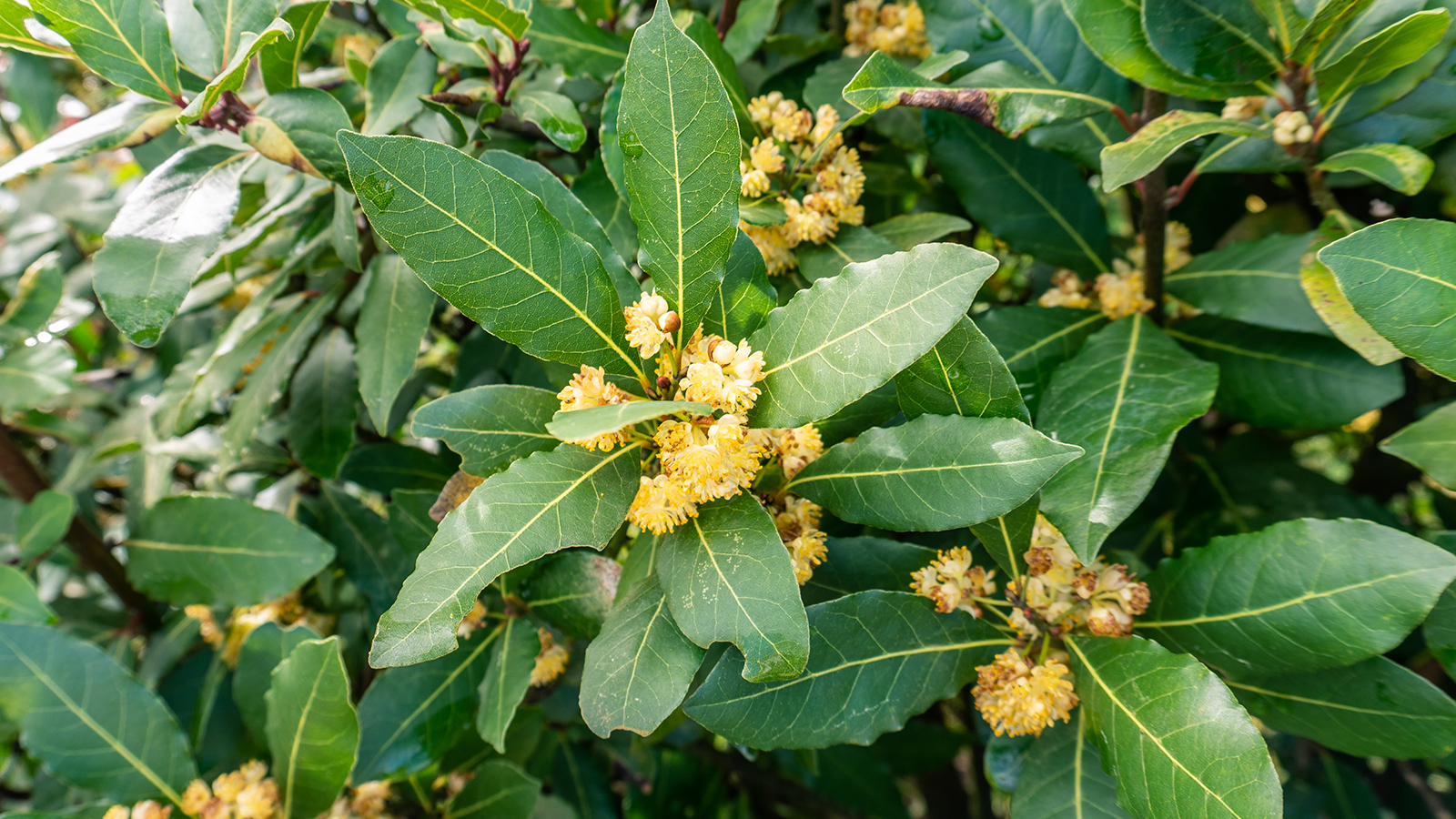Bay Laurel: Complete Care & Growing Guide
Bay laurel leaves are a delicious seasoning from the bay leaf tree, a lovely addition to your container garden or yard.


There are several varieties of laurel, many of which are excellent in use as hedges. Bay laurel, or sweet bay, is a plant native to the Mediterranean, but which is adaptable to many conditions. It is an evergreen that grows as a small tree in containers, or a tall, slender bush. The bay leaf tree is the source of our culinary seasoning, utilizing the leaves to scent and flavor dishes like stews and soups.
Quick Bay Laurel Facts
- Botanical name: Laurus nobilis
- Height: 20-40 feet (6-12 m)
- Spread: 20-40 feet (6-12 m)
- Sun exposure: Full sun to partial shade
- Soil requirements: Well draining
- Hardiness zones: USDA 7-10
- When to plant: Spring
Bay Tree Care
The bay tree is a slow-growing plant but it can reach heights of 20 feet (6 m) when mature. It responds well to pruning and makes either a manicured or informal hedge. Also known as Grecian or True laurel, the bay laurel tree was used to make the laurel wreaths that adorned ancient notables. It boasts dark green, elongated, leathery leaves and can grow as a single or multi-stemmed plant. This laurel is often seen in hedges, but can also be pruned to a container topiary. Here are some of its preferences:
- Light
The bay leaf tree is very adaptable and may be grown in either full or partial sun. It should receive at least 6 hours of bright sunlight daily. Plants in fierce, all-day sun may suffer. It is best to situate the plant where some protection from the noonday sun occurs. - Water
Sweet bay needs consistent water after planting and while very young. Once the plant has established it has minimum water needs and can withstand short periods of drought. Plants in the ground should be watered when the top 2 inches (5 cm.) of soil feels dry. Those in containers will require more frequent watering, as do those in full sun situations. Always water from the base of the tree at the root to prevent fungal spores from taking hold of the foliage. The plants need around half as much water in the winter months. - Temperature & Humidity
As a Mediterranean plant, bay laurel can tolerate quite a bit of humidity. The plant thrives in a temperate climate but can withstand short periods of freezing weather. It is hardy down to 20 degrees Fahrenheit (-6.7 C.). When temperatures are 35 degrees Fahrenheit (1.67 C.) or lower, the plant will go into dormancy and will not be actively growing. Sweet bay is hardy to United States Department of Agriculture zones 7-10. - Soil
In its native region, bay laurel grows in rocky, moist soils. In the home landscape, it will perform well in moist, well-draining soil of all types. In containers, potting soil or a 1 to 1 mixture of topsoil, compost, and peat provide a good medium. The key to good growth and prevention of root rot is adequate drainage. - Fertilizer
Feed sweet bay from spring through summer with a diluted, liquid plant food or time-release granules. Apply liquid feeds to the roots once per month in the growing season. Granular, time-release food should be applied in spring. A balanced fertilizer such as 10-10-10 is sufficient. - Problems, Pests & Diseases
Plants growing where there is insufficient drainage can get root rot. Other fungal issues, such as laurel wilt and Phytophthora, may be a problem. Foliar fungicides can combat foliar diseases, while a soil drench will prevent and cure root rots if caught early. The primary pests are scale and psyllids. Horticultural oils or insecticidal soaps sprayed on the leaf are helpful.
Tips for Planting Bay Laurel
The best time to plant these trees is early spring. Make sure there is very good drainage before planting the laurel. Always spread out the roots in a hole half again as large as the root ball. Pack soil gently around the root and then water it to settle it around them.
Some plants with slightly crooked stems will benefit from staking at planting to train the stems straight.
How to Grow Bay Tree in a Pot
A large clay or unglazed pot is a good option for growing bay in containers, allowing for evaporation of excess moisture. Make sure there are several large drainage holes. Use potting soil or a similar homemade mixture.
The container must be large enough for the tree to spread its roots. Container trees may also benefit from staking at planting.
Prior to planting the laurel, give it some bone meal mixed into the soil and water the soil thoroughly to settle it around the roots.
Sign up for the Gardening Know How newsletter today and receive a free copy of our e-book "How to Grow Delicious Tomatoes".
Repotting
Sweet bay laurels can tolerate being pot-bound for a while. However, container soil will lose its porosity and nutrients. Re-pot the laurel every year for the best results. Use fresh soil and increase the container size as needed.
Pruning a Bay Tree
Laurel plants are notably stoic when it comes to shaping and pruning. Prune bay trees early before the plants leave dormancy. Dead or broken stems may be removed at any time of the year.
Use sharp, sterile pruners to prevent introducing pathogens and making damaging cuts. These plants can be trained to a central leader and topiaried, sheared to a formal hedge, or simply left alone to produce a natural shape.
Propagation
Propagating bay laurel is difficult. Plants may be started from seed in a prepared flat that is kept warm, but germination is uncertain. Air layering is another method of propagation where an injury is made on a stem, and then damp moss is wrapped around the area and covered in plastic.
Another method is using semi-hard woody sections. Snap these from the plant, rather than cutting them. Strip the lower leaves and dip the end into rooting hormone, shaking off any excess. Insert the end into a potting medium and keep it moderately moist.
Overwintering
These plants will go dormant in the winter months and require little water or care when in the ground. In cooler regions, mulch around the root zone with leaf litter, bark chips, or other organic material. Plants in containers should be moved to a warmer location when a hard freeze is expected. Keep container plants moderately moist during the cold months.
Bay Tree Varieties
There is only one true or sweet laurel, but there are other varieties of laurel. Red bay or Persea borbonia can be substituted in recipes for sweet bay. There is also cherry laurel, a plant also used in hedges. Japanese, camphor, Portuguese, bog, and mountain laurels are also available.
Frequently Asked Questions
Are Bay Leaf and Bay Laurel the Same?
The bay laurel is the source of the culinary bay leaf. However, other varieties of laurel may also be called bay leaf and yet not be the culinary variety.
Are Bay Laurel Leaves Edible?
Eating a bay leaf won’t harm you but they are tough with woody little stems. This makes chewing them unpleasant. When used in cooking, the leaf is steeped and then removed before the dish is served.

Bonnie Grant is a professional landscaper with a Certification in Urban Gardening. She has been gardening and writing for 15 years. A former professional chef, she has a passion for edible landscaping.